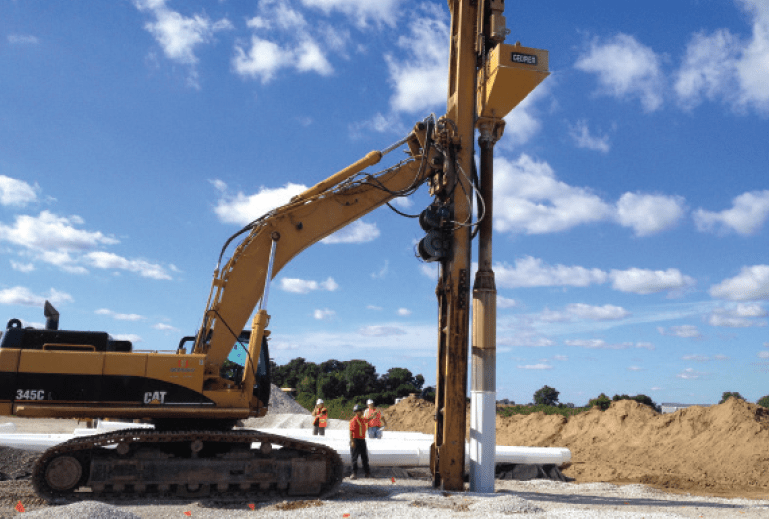
Geopier Rammed Aggregate Pier® Armorpact® System
The Armorpact® system allows for dramatically increased load-carrying capacity in very soft clays/silts or organic soil, and has proven to be a very cost-effective solution for supporting structures of all shapes and sizes in some of the softest soils found in Canada.
The system is essentially based on using a high density polyethylene (HDPE) confining shell and vertical impact ramming to construct high capacity Rammed Aggregate Pier® (RAP) elements for superior settlement control. What makes this system particularly impressive when compared to some other ground improvement systems, are the heavy vertical crowd force, vertical ramming energy and confinement provided by the HDPE sleeve. This action, along with the vertical ramming and heavy crowd pressure is unique to this particular system. These factors are essential as the result is a more highly engineered system with improved performance over other ground-improvement approaches.
This displacement method is also ideal for contaminated sites where spoils or over-excavation is cost-prohibitive or not an option. The Armorpact® system also provides cost-effective solutions for soils where temporary casing may increase construction costs or lower design capacities for other systems.
The construction process
The Geopier Armorpact® installation process displaces soil during installation and uses vertical impact ramming energy to construct RAP elements that exhibit high strength and stiffness in very soft soils.
A typical installation process flows as follows:
The Armorpact® sleeve is placed on the specially designed tapered mandrel and is driven into the ground using a strong static force augmented by high frequency vertical impact energy. Depths normally range from about 10 to 20 feet, depending on design requirements. This displacement process helps to eliminate spoils.
Once driven to design depth, the confining sleeve remains in place. Aggregate (clear stone or clean sand) is then placed and densified inside the confining HDPE sleeve. Compaction is achieved through static down force and dynamic vertical ramming from the hammer and mandrel. The process densifies aggregate vertically and forces the aggregate and confining sleeve laterally, expanding into the soft matrix soil. This results in lateral stress increase that, combined with the high stiffness element, provides excellent settlement control with superior strength and stiffness in soft clay and organic soils.
Following installation, RAP elements: support shallow foundations, floor slabs and mats; reduce liquefaction potential and improve stability support of embankments, walls and tank pads. The applied stresses are attracted to the stiff RAP elements, resulting in engineered settlement control.
RAP solutions are designed to provide total land differential settlement control and increase bearing support to meet and exceed project requirements in some of the most challenging soft soil conditions.
Mark Tigchelaar is president and founder of GeoSolv Design/Build Inc. Tigchelaar is a licensed engineer in both Ontario and Alberta, chair of the Industry Advisory Board of York University and the past chair of the Canadian Geotechnical Society-Southern Ontario section. For inquiries about this article or ground improvement, reach Tigchelaar at mark@geosolv.ca.
